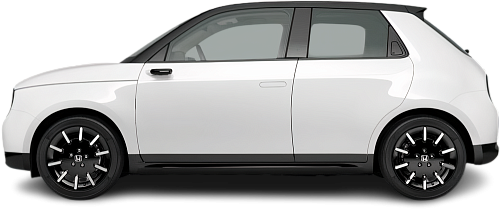Honda e Base vs Mercedes EQS 450 4MATIC
Struggling to Decide? Let AI Help!
Your AI Summary Is Ready!
General Info
Since both vehicles have been discontinued, they are now only available on the used car market. You can get the Honda e (2020-2022) for as low as €14900, while the Mercedes EQS 450 4MATIC (2022-2024) was never offered for sale in Europe.
The Honda e (2020-2022) is a Hatchback, whereas the Mercedes EQS 450 4MATIC (2022-2024) is a Sedan.
| Property | Honda e Base | Mercedes EQS 450 4MATIC |
|---|---|---|
| Years of Production | 2020-2022 | 2022-2024 |
| Current Status | Discontinued | Discontinued |
| Country of Manufacture | Japan | Germany, India |
| Body Style | Hatchback | Sedan |
| Market Availability | EU | USA |
| Price Europe (Used) | €14900 | - Price Europe (Used) |
| GCC Score | 4.6 | 7 |
Range and Efficiency
While the Mercedes EQS 450 4MATIC (2022-2024) offers a longer real-world range and a bigger battery, it is less energy-efficient than the Honda e (2020-2022).
| Property | Honda e Base | Mercedes EQS 450 4MATIC |
|---|---|---|
| Range (EPA) | - Range (EPA) | 547 km |
| Range (WLTP) | 222 km | 719 km |
| Range (GCC) | 189 km | 554 km |
| Battery Capacity (Nominal) | 35.5 kWh | 120 kWh |
| Battery Capacity (Usable) | 28.5 kWh | 108.4 kWh |
| Efficiency per 100 km | 15.1 kWh/100 km | 19.6 kWh/100 km |
| Efficiency per kWh | 6.63 km/kWh | 5.11 km/kWh |
| Range and Efficiency Score | 5.7 | 8.2 |
Charging
Both vehicles utilize a standard 400-volt architecture.
The Mercedes EQS 450 4MATIC (2022-2024) offers faster charging speeds at DC stations, reaching up to 207 kW, while the Honda e (2020-2022) maxes out at 46 kW.
The Mercedes EQS 450 4MATIC (2022-2024) features a more powerful on-board charger, supporting a maximum AC charging power of 11 kW, whereas the Honda e (2020-2022) is limited to 6.6 kW.
| Property | Honda e Base | Mercedes EQS 450 4MATIC |
|---|---|---|
| Max Charging Power (AC) | 6.6 kW | 11 kW |
| Max Charging Power (DC) | 46 kW | 207 kW |
| Architecture | 400 V | 400 V |
| Charge Port | CCS Type 2 | CCS Type 2 |
| Charging Score | 3.5 | 7.1 |
Performance
The Honda e (2020-2022) is rear-wheel drive, while the Mercedes EQS 450 4MATIC (2022-2024) offers an all-wheel drive system.
The Mercedes EQS 450 4MATIC (2022-2024) boasts greater motor power and accelerates faster from 0 to 100 km/h.
| Property | Honda e Base | Mercedes EQS 450 4MATIC |
|---|---|---|
| Drive Type | RWD | AWD |
| Motor Type | PMSM | PMSM (front), PMSM (rear) |
| Motor Power (kW) | 100 kW | 265 kW |
| Motor Power (hp) | 134 hp | 355 hp |
| Motor Torque | 315 Nm | 800 Nm |
| 0-100 km/h | 9 s | 5.6 s |
| Top Speed | 145 km/h | 210 km/h |
| Performance Score | 2.8 | 5.9 |
Dimensions
The Mercedes EQS 450 4MATIC (2022-2024) is longer and wider, but about the same height as the Honda e (2020-2022).
The Mercedes EQS 450 4MATIC (2022-2024) boasts a more extended wheelbase.
| Property | Honda e Base | Mercedes EQS 450 4MATIC |
|---|---|---|
| Length | 3894 mm | 5216 mm |
| Width (with Mirrors) | - Width (with Mirrors) | 2125 mm |
| Width (w/o Mirrors) | 1752 mm | 1926 mm |
| Height | 1512 mm | 1512 mm |
| Wheelbase | 2538 mm | 3210 mm |
Cargo and Towing
The Mercedes EQS 450 4MATIC (2022-2024) provides more cargo capacity, featuring both a larger trunk and more space with the rear seats folded.
Neither car is equipped with a frunk (front trunk).
The Mercedes EQS 450 4MATIC (2022-2024) has a towing capacity of up to 750 kg, whereas the Honda e (2020-2022) is not officially rated for towing in the EU.
| Property | Honda e Base | Mercedes EQS 450 4MATIC |
|---|---|---|
| Number of Seats | 4 | 5 |
| Curb Weight | 1588 kg | 2630 kg |
| Cargo Volume (Trunk) | 171 l | 620 l |
| Cargo Volume (Max) | 861 l | 1700 l |
| Cargo Volume (Frunk) | - Cargo Volume (Frunk) | - Cargo Volume (Frunk) |
| Towing Capacity | - Towing Capacity | 750 kg |
| Cargo and Towing Score | 3.8 | 6.3 |




